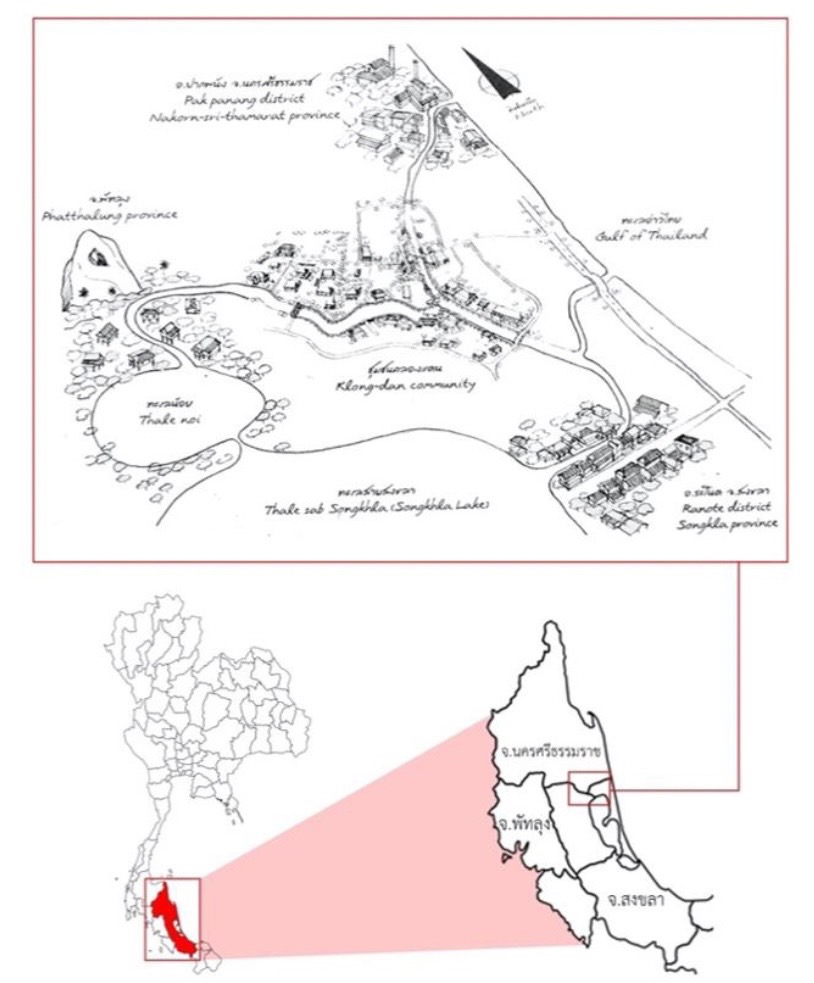Spatial Design and Management Guidelines Promoting Human Perception Toward Cultural Environment for Community-Based Tourism: A Case Study of Khlong Daen in Songkhla and Nakhon Si Thammarat Provinces
Main Article Content
Abstract
This research studies and analyses the human perception towards cultural environments of community and its surrounding areas, reflecting the identity of local cultures having high potentials in promoting tourism. Khlong Daen community located on the border between Songkhla and Nakhon Si Thammarat is selected as a case study. This paper proposes a spatial design and management guidelines promoting human perception towards cultural environments for community-based tourism. This research employs qualitative methods including mental mapping from 2 groups of participants; insiders and outsiders (17 people), coupled with photography and interviews to identify specific physical characteristics of the study areas. Subsequently, analysis results in the forms of collective cultural mappings were assessed by focus group discussions. The study has found that the participants can recognize and perceive cultural environments through participative events and activities in the community. However, there are two differences between insiders’ and outsiders’ viewpoints which are cognitive mappings and sequences of important areas indicated on the mappings. Even though all the participants can recognize tangible and intangible cultural environments as well as some cultural environments that no longer exist the area, all these cultural environments can be categorized into 2 types. They are nodes (mentioned more than 25 percent on all the mappings) and sub nodes (mentioned less than 25 percent on all the mappings). The identified physical elements of the study area can also be used to propose a spatial design and management guidelines that help promote for community-based tourism in Khlong Daen community. Lastly, such a research methodology, techniques and processes presented in this paper could be replicated to study other potential communities in Songkhla and Nakhon Si Thammarat provinces as well as elsewhere to promote cultural tourism organized by the locals.
Downloads
Article Details

This work is licensed under a Creative Commons Attribution-NonCommercial-NoDerivatives 4.0 International License.
All material is licensed under the terms of the Creative Commons Attribution 4.0 International (CC-BY-NC-ND 4.0) License, unless otherwise stated. As such, authors are free to share, copy, and redistribute the material in any medium or format. The authors must give appropriate credit, provide a link to the license, and indicate if changes were made. The authors may do so in any reasonable manner, but not in any way that suggests the licensor endorses you or your use. The authors may not use the material for commercial purposes. If the authors remix, transform, or build upon the material, they may not distribute the modified material, unless permission is obtained from JARS. Final, accepted versions of the paper may be posted on third party repositories, provided appropriate acknowledgement to the original source is clearly noted.
References
Horayangkura, V. (2006). Human Behavior and Environment Behavioral Basis for Design and Planning. Bangkok: The Chulalongkorn University Press.
Office of Natural Resources and Environmental Policy and Planning. (2005). Cultural Environment Conservation System. Bangkok: Office of Natural Resources and Environmental Policy and Planning.
Sarobol, S. (2003). Community-Based Tourism: Concept and Experience in Northern of Thailand. Bangkok: The Thailand Research Fund (TRF).
Suwannachart, J. and others. (2011). A Pilot Project on Housing and Community in The Southern Region Klong Dan Community Project. Faculty of Architecture, Rajamangala University of Techonology Srivijaya, Songkhla, Thailand.
Surachetthapong, C. (2011). Structures and Element of Chiang Kan City’s Cultural Environment Identity (Master’s Thesis) Faculty of Architecture, Silpakorn University, Thailand.
The Royal Society of Thailand. (1982). Image. Retrieved December 21, 2018 from https://www.novabizz.com/NovaAce/Intelligence/%E0%B8%88%E0%B8%B4%E0%B8%99%E0%B8%95%E0%B8%A0%E0%B8%B2% E0%B8%9E.htm
The Thailand Community Based Tourism Institute. (1997). The Community-Based Tourism. Retrieved December 21, 2018 from https://cbtyouth.wordpress.com/cbt-youth/cbt/
Towinus, S. (2011). A Study for Maneuver of Architectural Heritage Atlas of Rak Klong Bangpra Community, Trat Province (Master’s Thesis), Silapakorn University, Thailand.
Wertheimer, M. (2012). Experimental studies on see-ing motion. In L. Spillman (Ed.), On perceived motion and figural organization, edited by Lothar Spillmann (pp. 1–91). Cambridge, MA: MIT Press.


